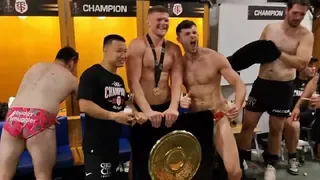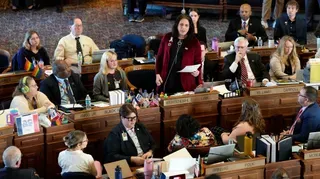May 4, 2011
Effort under way to commemorate AIDS vigil
Kevin Mark Kline READ TIME: 4 MIN.
Braving the elements, condemnations from passersby, and failed attempts over the years to evacuate them, a group of AIDS activists held vigil in the heart of San Francisco for 10 years to protest government inaction toward the deadly disease.
It was the city's longest running act of civil disobedience, launched October 27, 1985 when two HIV-positive men chained themselves to the doors of 50 UN Plaza, a federal building facing Market Street. They were soon joined by a core group of volunteers who kept vigil 24 hours a day, seven days a week.
The protest and sit-in was officially known as the ARC/AIDS Vigil, ARC standing for AIDS Related Complex. It came to an end a decade after it started when a severe rainstorm blew away the tent encampment.
Just three demonstrators remained toward the end, according to media accounts in December 1995. Since then the AIDS vigil has been mostly forgotten to the history books and the fading recollections of participants.
But an effort is now under way to revive memories of the seminal event in San Francisco's United Nations Plaza near City Hall. Supporters hope to place a plaque at the location in order to commemorate what took place during the early days of the AIDS epidemic, when a diagnosis usually meant death and President Ronald Reagan refused to address the crisis.
"It is important as a city to honor what happened and recognize the importance of what took place," said openly gay Supervisor David Campos, who arrived in the city two years after the end of the vigil.
Campos's office is drafting a resolution to seek official city support for the historical marker. His aides are also trying to determine what the protocol is to put a plaque on federal property or if there is a city-owned location that would be appropriate. The sidewalk in front of 50 UN Plaza is maintained by the city.
The Department of Public Works would need to be consulted, and the Arts Commission would have to approve the plaque design, according to the supervisor's office. He expects the board will vote on the resolution in May and has pledged to help fundraise to pay for the plaque.
Terrrie Frye, who served as an on-site cook in the early years of the vigil, approached Campos to seek his support for the project. Last year, to mark the 25th anniversary of the vigil's start, Frye created a scrapbook using archival photos, journals, and materials housed at the GLBT Historical Society's archives.
During the 2010 Pride celebration, the Radical Faeries allowed Frye to display it at their village as their booth is located where the vigil took place. Now Frye is working to get approval for a more permanent reminder of how locals, fed up with governmental indifference toward people living with AIDS, took to the streets to demand action.
According to the archival materials, the demonstrators listed six demands they wanted to see federal officials act on, including publicly recognizing AIDS and condemning AIDS-related discrimination. They also were calling for a "Manhattan Project" type effort to find an AIDS cure.
"We need $500 million dollars in federal money for research to find a cure for ARC - AIDS Related Complex," read one flier handed out by vigil organizers. "We make a moral appeal to the American government to condemn AIDS hysteria and bigotry through education."
Numerous politicians joined the vigil and were arrested, helping bring media attention to the demonstration. According to old news clippings, gay former San Francisco Supervisor Harry Britt and former Berkeley Mayor Loni Hancock, now a state senator, both were arrested after chaining themselves to the building.
One flier advertised a "Breakfast with Nancy" at the vigil one February, referring to Congresswoman Nancy Pelosi (D-San Francisco), now the House minority leader. In the summer of 1987, two years into the vigil, Pelosi entered Congress and her main objective at the time was to demand action on AIDS.
Over time the vigil turned into a place where people, whether living with AIDS themselves or struggling to care for or grieve for a loved one, could find camaraderie and comfort.
"Once a man walked up, and as soon as he saw me, he started crying. He said, 'I made his favorite dish, spaghetti and meatballs, and he threw it at me.' His partner had dementia," recalled Frye, who helped prepare meals at the on-site kitchen for vigil participants between 1986 and 1991.
More than just an encampment for demonstrators, who would spend the night sleeping on mattresses or inside tents, the vigil also served as a clearinghouse for people to learn the latest news about AIDS. The volunteers also used bleach to clean injection drug users' needles and passed out condoms.
"It was a great place to get information from around the world," recalled Frye, noting the number of international visitors and tourists who would stop by the vigil.
It was also a site to collect the names of those lost to AIDS, several of whom died while taking part in the vigil. Both of the men who began the protest by handcuffing themselves at the site - Steve Russell and Frank Bert - died prior to the vigil's end, said several participants.
"It's a good idea as at least 20 people I knew died there and it'd be nice to have a memorial. And when I say died, I mean died right at UN Plaza," Clark Sullivan, a vigil participant, told the Bay Area Reporter.
Garth Ferguson, another longtime participant, also said he welcomes seeing the city commemorate the vigil and the people who kept it going for so long.
"I think it is a good idea because nobody knows what went on there because it was a while ago now," said Ferguson, whose lover back then committed suicide after learning he was HIV-positive. "I can tell you I think it saved a lot of lives because we were not condemning people for being addicts. We wanted people to be safe and live."
Ferguson, now 65, said he remained to the very end.
"I was there the whole time. There was a five-day rainstorm and the wind just took all of our stuff and blew it away. There was no place for us to stay," recalled Ferguson.
Anyone interested in helping with the plaque efforts should email mailto:[email protected].







